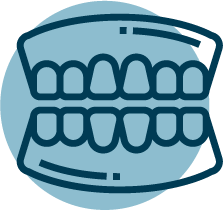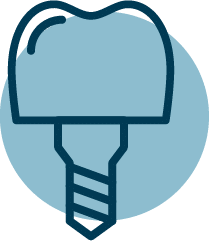
Overview
Baker and Graham provides a wide variety of preventative and restorative dental treatments to keep your smile healthy for years to come. Here are some of our most common procedures and treatments.
Schedule Today
Regular Exams
and Cleanings
Regular exams are an important part of maintaining your oral health and your total body health. During your regular exam, we will check for any problems that you may not be able to see or feel, look for cavities and other signs of tooth decay, inspect your teeth and gums for gingivitis and signs of periodontal disease, and provide a thorough teeth cleaning.
Your regular exam will take about 45 minutes and we recommend one every six months. These visits give you a chance to talk to your dentist about your oral health and create a detailed treatment and prevention plan for in between appointments. We offer regular exams by appointment only.
Schedule an Appointment
Bonding
Bonding
Dental bonding is a conservative way to repair slightly chipped, discolored, or crooked tooth. During dental bonding, we place a white filling onto your tooth to improve its appearance. Plus, the filling “bonds” with your tooth, and because it comes in a variety of tooth-colored shades, it closely matches the appearance of your natural teeth.
Bridges
Bridges
A bridge replaces missing teeth to improve the look of your smile, help maintain the shape of your face, and alleviate stress on your bite. We can make bridges from gold, alloys, porcelain, or a combination of these materials, and bond them to the surrounding teeth for support.
The success of your bridge depends on the foundation— the surrounding teeth, gums, or bone to which it attaches. Therefore, it’s very important to keep your existing teeth, gums, and jaw as healthy and strong as possible.
Crowns
Crowns
Dentists use dental crowns as a restorative procedure to strengthen your tooth and improve its shape. Moreover, crowns are most often used for teeth that are broken, worn, or have portions destroyed by tooth decay.
A crown is a “cap” that dentists cement onto an existing tooth, covering the entire portion above the gum line. In effect, the crown becomes your tooth’s new outer surface. Dentists can make crowns from porcelain, metal, or a combination of both. Dentists often prefer porcelain crowns because they mimic the color and translucency of natural teeth while being very strong. Unlike fillings, which apply metal or porcelain directly into your mouth, dentists fabricate crowns in a lab using your unique tooth impression. A dental lab technician examines all aspects of your bite and jaw movements, then sculpts a perfectly fitting crown to ensure your bite and jaw function normally after placement.
Dentures
Full & Partial Dentures
Dentures are a removable, natural-looking replacement for natural teeth. However, there are two types of dentures: full and partial. Dentists provide full dentures to patients after removing all of their natural teeth. Partial dentures attach to a metal frame connected to your natural teeth, filling in gaps where permanent teeth have been removed. Just like natural teeth, you need to properly care for dentures. Use a gentle cleanser to brush your dentures, always keep them moist when they’re not in use. Additionally, be sure to keep your teeth and gums clean, too!
Flouride
Dental Flouride
Fluoride is effective in preventing cavities and tooth decay and in preventing plaque from building up and hardening on the tooth’s surface. Plus, a fluoride treatment in your dentist’s office takes just a few minutes. After the treatment, we may ask patients not to rinse, eat, or drink for at least 30 minutes to allow the teeth to absorb the fluoride. However, depending on your oral health or your doctor’s recommendation, you may be required to have a fluoride treatment every three, six, or 12 months.
Dental
Sealants
Sometimes brushing is not enough, especially when it comes to those hard-to-reach spots in your mouth. Plus, it is difficult for your toothbrush to get in-between the small cracks and grooves on your teeth. However, if left alone, those tiny areas can develop tooth decay. Sealants give your teeth extra protection against decay and help prevent cavities.
Furthermore, dental sealants are a plastic resin that bonds and hardens in the deep grooves on your tooth’s surface. Plus, when a tooth is sealed, the tiny grooves become smooth and are less likely to harbor plaque. Additionally, with sealants, brushing your teeth becomes easier and more effective against tooth decay.
Moreover, sealants are typically applied to children’s teeth as a preventive measure against tooth decay after the permanent teeth have erupted. However, adults can also receive sealants on healthy teeth. It is more common to seal “permanent” teeth rather than “baby” teeth, but every patient has unique needs, and your dentist will recommend sealants on a case-by-case basis.
Sealants last from three to five years, but it is fairly common to see adults with sealants still intact from their childhood. Lastly, a dental sealant only provides protection when it is fully intact, so if your sealants come off, let your dentist know, and schedule an appointment for your teeth to be re-sealed.

Extractions
Extractions
There are times when it is necessary to remove a tooth. Furthermore, decay, infection, orthodontic correction, or problems with erupting wisdom teeth are common causes. However, whatever the reason, when it is determined that a tooth needs to be removed, your dentist may extract the tooth during a regular checkup or may request another visit for this procedure. Plus, this process is typically very quick, but it is important that you speak to your dentist beforehand to share any concerns or preferences for sedation.
Moreover, once a tooth has been removed, neighboring teeth may shift, causing problems with chewing or with your jaw joint function. To avoid these complications, your dentist may recommend that you replace the extracted tooth with a partial denture, implant, or other tooth replacement.
Fillings
Dental Fillings
Fillings are an extremely common dental restorative that is used to repair damage from cavities. However, traditional fillings may include gold, porcelain, or composite, while newer fillings include ceramic and plastic compounds that mimic the appearance of natural teeth. Plus, these compounds, often called composite resins, are typically used on the front teeth where a natural appearance is important.
Furthermore, there are two different kinds of fillings: direct and indirect. Direct fillings are fillings placed directly into a prepared cavity in a single visit. Indirect fillings generally require two or more visits. Additionally, these fillings include inlays, and veneers fabricated with ceramics or composites.
Implant Restoration
Dental Implant Restoration
An implant is a new tooth made of metal and porcelain that looks just like your natural tooth. It’s composed of two main parts: One part is the titanium implant body that takes the place of the missing root, and the second part is the tooth-colored crown that is cemented on top of the implant. With implant treatment, you can smile confidently knowing no one will ever suspect you have a replacement tooth.
However, if you have missing teeth, it is crucial to replace them. Without all your teeth, chewing and eating can destabilize your bite and cause you discomfort. Plus, when teeth are missing, your mouth can shift and even cause your face to look older. Implants are a great way to replace your missing teeth, and if properly maintained, can last a lifetime!
In addition to tooth replacement, implants may be used to anchor dentures, especially lower dentures that tend to shift when you talk or chew. However, for patients with removable partial dentures, implants can replace missing teeth so you have a more natural-looking smile.
Nightguards
Nightguards
If you often wake up with jaw pain, earaches, or headaches, or if you find yourself clenching or grinding your teeth, you may have a common condition called “bruxism”. Many people do not even know that they grind their teeth, as it often occurs when one is sleeping. If not corrected, bruxism can lead to broken teeth, cracked teeth, or even tooth loss.
There is an easy, non-invasive treatment for bruxism: nightguards. Nightguards are an easy way to prevent the wear and damage that teeth-grinding causes over time. Custom-made by your dentist from soft material to fit your teeth, a nightguard is inserted over your top or bottom arch and prevents contact with the opposing teeth.
Veneers
Veneers
You no longer need to hide your smile because of gaps, chips, stains, or misshapen teeth. With veneers, you can easily correct your teeth’s imperfections to help you have a more confident, beautiful smile. Veneers are natural in appearance, and they are a perfect option for patients wanting to make minor adjustments to the look and feel of their smile.
Veneers are thin, custom-made shells made from tooth-colored materials (such as porcelain), and they are designed to cover the front side of your teeth. To prepare for veneers, your doctor will create a unique model of your teeth. This model is sent to the dental technician to create your veneers. Before placing your new veneer, your doctor may need to conservatively prepare your tooth to achieve the desired aesthetic result.
When placed, you’ll be pleased to see that veneers look like your natural teeth. While veneers are stain-resistant, your doctor may recommend that you avoid coffee, tea, red wine, and tobacco to maintain the beauty of your new smile.
Wisdom Teeth
Dentists identify wisdom teeth as molars located at the back of your mouth. These teeth usually appear in late teens or early twenties, but they may become impacted (fail to erupt) due to lack of room in the jaw or angle of entry. When a wisdom tooth becomes impacted, a dentist may need to remove it. If left untreated, it can cause gum tenderness, swelling, or even severe pain. Impacted wisdom teeth that are partially or fully erupted tend to be quite difficult to clean and are susceptible to tooth decay, recurring infections, and even gum disease.
Dentists typically remove wisdom teeth in the late teens or early twenties because the roots have not fully formed and the bone surrounding the teeth is less dense. These two factors can make extraction easier as well as shorten the recovery time.
For more information on our common procedures in Hattiesburg, be sure to contact us today!

